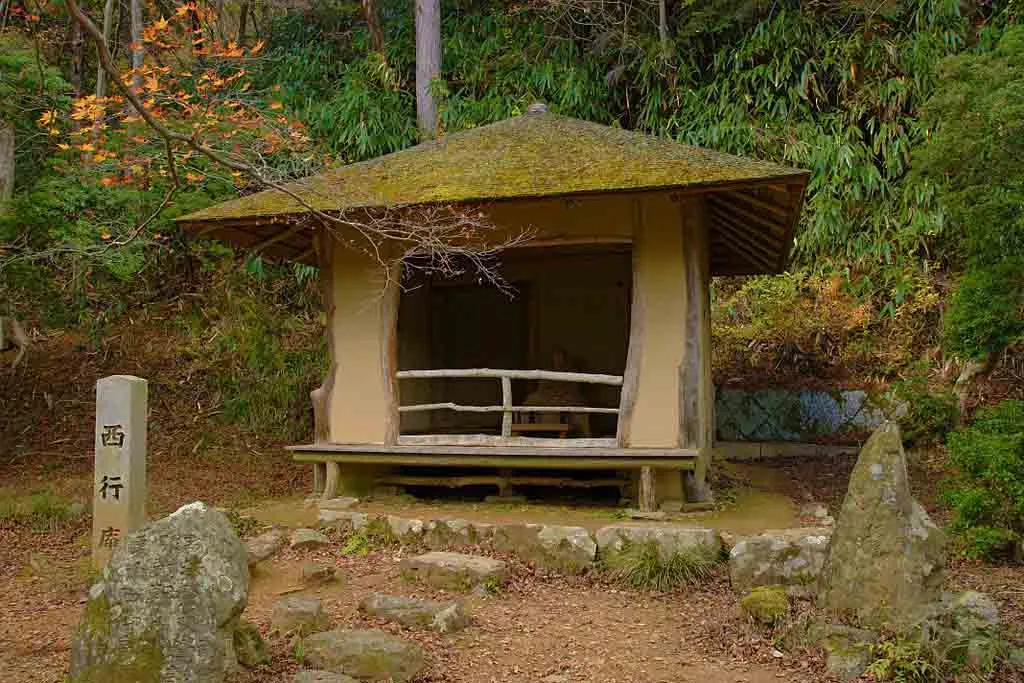History of Japanese aesthetics (2): Kamakura and mujo
Japanese aesthetics are known for simple and minimalist design details and a unique appreciation of natural beauty. There have been a couple of decisive moments in history that helped cement those qualities. The “History of Japanese Aesthetics” reviews the social background of the 1) Heian, 2) Kamakura, 3) Muromachi and 4) Edo periods and discusses how these periods affected the formation and crystallization of Japanese aesthetics.
You are on 2) The Kamakura Era
The Kamakura Era (1192-1333): Conflicts between grace and brutality
In the previous chapter, we reviewed the Heian aristocrats in ancient Japan. They secured their status through blood lines and didn’t have their own soldiers. As such, they tried to avoid bloody wars and took pride in leading a cultural life full of grace. The aesthetics of mono no aware was their life motto.
But a country cannot be led by a group of escapists. Soon, regional military leaders – later called samurai – started increasing their influence in various parts of Japan. Eventually they became powerful enough to threaten the aristocrats in the then-capital Kyoto. Aristocrats tried to downplay samurai groups as brutal, rough people with no culture. But it did do little to stop samurai’s ambitions. Eventually in 1192, the Minamoto’s, a regional military clan in Eastern Japan, declared that they were the leaders of the samurai around the country. It resulted in a dual power regime that had both a shogun (the head of samurai) and an emperor (the head of aristocrats). This era is called the Kamakura era (1192-1333) because the Minamoto’s were headquartered in Kamakura (about 50km from Tokyo).
Ever since, the shogun kept increasing his power as a dictator all the way until Japan finally decided to modernize the country in the middle of the 19th century. But during Kamakura era, the shogun regime was very new and unstable. They tried to implement immature or inconsistent policies to cause confusion and suffering among people. Conflicts occurred everywhere.
From the “Tale of Heiji,” which is about the civil war at the end of the Heian era that featured the emergence of military leaders such as the Genji’s and Heike’s. Conflicts were a norm in the Kamakura era.
Interesting facts: Fujiwara Teika, who represents mono no aware aesthetics (see the previous post), didn’t survive turbulent politics of Kamakura era. Born into a high-ranking aristocrat family, Teika was an ambitious bureaucrat. As stubborn and uncompromising as he was in his pursuit of art and beauty, he was also stubborn in his career. As the society became volatile and power struggles between aristocrats and military elites got ugly and nasty, Teika couldn’t stay away from trouble and failed to get promoted. Disappointed, he eventually abandoned his ambitions and became a Buddhist priest when he was 71.
Teika was not alone. Amid excruciating social turbulence, the majority of the public was left in poverty and feeling desperate. Concerned people were disillusioned and weary with the power struggle that brought nothing but destruction. Many artists and intellectual abandoned the social life and became hermits in order to avoid the ugliness of the reality. In a sense, Kamakura culture was a hermit culture. It was also during the Kamakura era that the notion of mujo was visited and revisited to become highly crystallized, reflecting the ill-fated social environment. The pure, intact land of aesthetics guarded by the intelligent and sensible Heian aristocrats was now gone. It was time for culture to face reality.
隠遁文学・無常 (Hermit literature and crystallization of “mujo“)
Some of the works done by the “hermit” artists during the Kamakura era are considered among the best in Japanese history. Their keen/critical eyes revealed the contradictory nature of human relationships, and had the ability to elevate those observations into profoundly philosophical yet lyrical pieces of art.
西行 (Saigyo) 1118-1190
西行 (Saigyo) was born into a high-ranking samurai family, and was promised a bright future. But he decided to abandon his career at the age of 23 and became a priest-wanderer-poet. He traveled throughout the country, living in a so-an (a small, bucolic makeshift hut), and wrote a plethora of waka poems. Many of them honestly confessed his dilemma, choosing between the attachment for what he’d left behind – love, family among others – and the yearning for solitude and pure, uninterrupted natural beauty.
Saigyo especially loved – or rather was obsessed with – sakura (cherry blossoms), and lived in the Yoshino mountains in Nara prefecture for three years. Yoshino is still famous for its plentiful sakura trees that cover entire mountain ranges. Though astonishingly beautiful, the Japanese consider sakura as a symbol of mujo beauty because the petals last barely a week before they are quickly blown away.
Left: Sakura in full bloom in Yoshino mountains.
Right: Saigyo-an, Yoshino, which is believed to have been Saigyo’s dwelling during his stay in Yoshino. It’s a small hut standing in the thick of nature.
Although nature is beautiful, it must have been difficult to live alone in the vast mountain regions where unknown and dangerous creatures and mysterious spirits roamed freely. Food was difficult to come by, nights were menacing, wind rattled his hut, rain soaked his clothes and snow froze his skin. But he patiently waited for the sakura season by embracing Buddhism as his spiritual guide. Once a year in early spring, the sakura would bloom to cover the entire mountainside with faintly pink petals, as if the world was transformed into something else. In his small hut, Saigyo must have seen the mesmerizing duality in nature – beauty and threat, grace and mercy, and pleasure and pain. At the end of his enchanting yet painful journey in solitude, Saigyo wrote a waka that almost predicted his death:
ねかはくは 花のしたにて 春しなん そのきさらきの もちつきのころ
I wish if I could die beneath a full moon and cherry blossoms in the same time of the season that Buddha “abandoned his body.”
Saigyo actually passed away only one day after the date that Buddha is believed to have passed away. After his lone adventure in the world full of mujo, Saigyo wished to dissolve into nature and be embraced by Buddha’s mercy. And he did it.
鴨 長明 (Kamo no Chomei, 1155-1216)
鴨長明 (Kamo no Chomei, 1155- 1216) was born in a high ranking family of a shrine administrator. Like Saigyo, he started his career with bright hopes, but as his family became involved in a turf war, he could never get the posts he wanted. While he was recognized for his waka writing talent (which was still large part of the social skills among the upper classes), he was disillusioned by the competition-ridden society and decided to abandon social life. He settled in a rural part of Kyoto, lived in a so-an and and wrote “方丈記 (Hojo-ki, an Account of my Hut) in 1212,” one of the oldest and finest memoirs in Japanese literature. Hojo-ki has a famous introduction that perfectly summarizes the mujo sentiments in the Kamakura era:
行く川のながれは絶えずして、しかも本の水にあらず。よどみに浮ぶうたかたは、かつ消えかつ結びて久しくとゞまることなし。
The flow of the river is ceaseless and its water is never the same. The bubbles that float in the pools, now forming, are not of long duration.
Translation by Donald Keene
Kamo no Chomei goes on and writes down his observations on how society worked and how many of the things that people were fighting for were unimportant. It is eye-opening to see that he already felt the same kind of stresses that we modern people feel almost a thousand years later.
もし、己が身数ならずして、権門のかたはらに居るものは深く悦ぶことあれども、大きに楽しむにあたはず。
もし貧しくして富める家の隣にをるものは、朝夕すぼき姿を恥ぢてへつらひつら出で入る。
もし狭き地に居れば、近く炎上する時、その害をのがるゝことなし。もし辺地にあれば、往反わづらひ多く、盜賊の難はなはだし。
また、勢いあるものは貪欲ふかく、ひとり身なるものは人に軽めらる。財(たから)あればおそれ多く、貧しければうらみ切なり。
人を頼めば身他の有なり。人をはぐくめば心恩愛につかはる。
世にしたがへば身くるし。したがはねば狂せるに似たり。
いづれの所をしめて、いかなるわざをしてか、しばしもこの身をやどし、玉ゆらも心をやすむべき。
If you are born into a lower class, you need to cave in to people in power. If you are poor, you have to feel embarrassed when you see your rich neighbor.
If you chose live to in a popular district, you have to risk losing your home from fire. But if you chose to live in a remote area, you have to sacrifice convenience. And you could easily be robbed.
You become greedy as you get promoted, but you are despised otherwise.
You can’t stop worrying about your fortune, but you can’t stop feeling resentful if you don’t have it.
You lose your self if you rely too much on someone else, but your affection to someone you take care of could narrow your life options.
You feel stressed when you always try to follow common sense or social norm, but else you would be treated as a crazy person.
At the end of the day, there is no place in this world where you can feel completely relaxed and yourself.
Whereas most of us try to accept the society as is and take care of the stresses by themselves, Kamo no Chomei had no hesitation to leave them behind to pursue peace of mind.
かなむは小さき貝を好む。
これ事知れるによりてなり。みさごは荒磯にいる。すなはち人を恐るるがゆえなり。我またかくのごとし。事を知り、世を知れれば、願はず、わしらず、ただ静かなるを望みとし、憂へ無きを楽しみとす。
Hermit crabs are wise enough to choose small shells. Ospreys live in remote beaches. They don’t like to be around people. Neither do I.
The more you know about this world and how things work, the more desire you would feel for tranquility and serenity that cannot be interrupted by anyone. It is a lot more pleasing to have no wishes so that you have no stress.
吉田兼好 (Yoshida Kenko, 1283? – 1352?)
Maybe the most well-known name in hermit culture in the era is 吉田兼好 (Yoshida Kenko), who wrote 徒然草 (Turezure-gusa, Essay in idleness). Like Kamo no Chomei, Kenko was born into a family of a high-ranking shrine administrator and started a career as a bureaucrat. However, he decided to abandon his social status when he was about 30, and after that, devoted himself to Buddhism and writing. (But we don’t know much about his life)
The introduction of Essay in Idleness is so famous that probably everyone in Japan could recite it. However, the meaning is a ambiguous due to the choice of words and can be interpreted in different ways.
つれづれなるままに、日暮らし、硯にむかひて、心にうつりゆくよしなしごとを、そこはかとなく書きつくれば、あやしうこそものぐるほしけれ。
What a strange, demented feeling it gives me when I realize I have spent whole days before this inkstone, with nothing better to do, jotting down at random whatever nonsensical thoughts have entered my head.
Translation by Donald Keene
“Tsurezure” is an ancient word that is no longer used, but it survived as a dialect in the region I grew up, where people used it to describe a situation in which you have no engagements, no obligations nor anything particular to do. It’s a subtle feeling of being left out, although you are willing to accept it. Tsurezure is an ambiguous, absent and vacant state of mind and you can’t easily decide if it’s a positive or negative feeling. You just feel it. It was revolutionary that Kenko was already sensing such a profound, metaphysical feeling of vanity like Marcel Proust. Kenko jotted down whatever came to mind as he pursued his practice of “doing nothing” challenging the social norms, which often became overwhelming, crazy or outlandish.
あだし野の露きゆる時なく、鳥辺山の烟立ちさらでのみ住みはつるならひならば、いかにもののあはれもなからん。世はさだめなきこそいみじけれ。
The field of Adashino is always wet, and the soot from Toribe Mountain never stops rising. There will be no oohs and ahhs in our life if it was eternal. Our life is priceless exactly because it has an ending.
NOTE: the Adashino and Toribe Mountains are places in Kyoto that have been used to cremate and bury dead people.
平家物語 (Heike Monogatari, The Tale of Heike)
The Tale of Heike is believed to have been written during the Kamakura era, but the author is unknown. Reflecting the fierce competition among opposing military clans, the tale tells an epic saga of the Heike clan, their rapid ascent to the power, and then their decline, tragically defeated by the Genji clan. But even the Genji were not absolute winners or heroes: the Genji leader ends up being assassinated by the family member, resentful of his success. The saga consistently reminds readers that we live in the world of mujo, in which there are no winners or losers and everyone eventually passes away. The introduction of the Tale of Heike is still very popular today because of its poetic rhythm that soberly yet beautifully describes the true face of mujo.
祇園精舎の鐘の声、諸行無常の響きあり。
沙羅双樹の花の色、盛者必衰の理をあらはす。
奢れる人も久からず、ただ春の夜の夢のごとし。
猛き者も遂にはほろびぬ、 偏 ひとへ に風の前の塵におなじ。
The Jetavana Temple bells
ring the passing of all things.
Twinned sal trees, white in full flower,
declare the great man’s certain fall.
The arrogant do not long endure:
They are like a dream one night in spring.
The bold and brave perish in the end:
They are as dust before the wind.
Translation by Royall Tyler
鎌倉新仏教 (New schools of Buddhism emerged during the Kamakura Era)
It’s also important to know that new schools of Buddhism emerged during the Kamakura era in order to salvage and console non-elite, powerless people, whose lives were severely affected by poverty and warfare. There are six notable Kamakura schools, two of which are Zen. Although they had different platforms, they all opened the door of Buddhism – a religion of elites until then – to ordinary people, who enthusiastically welcomed them since they taught them that they were embraced and forgiven by the mercy of Buddha regardless of their social status. It was revolutionary in that for the first time in history, Buddhism sincerely attempted to face the cruel reality that people at the bottom of the social ladder suffered.
It had significant impacts at a philosophical level, and especially Zen (Rinzai-shu) played critical roles in elevating Japanese aesthetics into crystallized abstraction.
Table: Six schools of the Kamakura New Buddhism
| School | Founder | About |
| 浄土宗 (Jodo shu) | 法然 (Honen, 1133-1212) | After hard training and relentless studies, Honen finally decided that Buddha’s mercy was open to everyone including people who couldn’t even read the scripture. He started the nembutsu, which was a short chant that could be practiced by anyone. |
| 浄土真宗 (Jodo shinshu) | 親鸞 (Shinran, 1173-1262) | Shinran elevated Honen’s teaching to a new level, and declared that even people who didn’t follow any religious practices were forgiven by the profound mercy of Buddha. Jodo Shinshu is the largest school of Buddhism in Japan today. |
| 時宗 (Jishu) | 一遍 (Ippen 1239-1289) | Ippen opened Buddhism to even the poorest of the poor. He traveled around the country and used dance and chants as a teaching method so that even illiterate people could understand it. During the Muromachi era, artists that came from socially discriminated classes used Jishu priest status to be accepted by the society. |
| 法華宗 (Hokke shu) | 日蓮 (NIchiren, 1222-1282) | Nichiren maintained that the Hokke-kyo scripture was the only teaching to be strictly followed, and pursued uncompromising practices. Kenji Miyazawa, one of the most prominent authors in the early 20th century who wrote “Night of Galactic Railroad,” was an enthusiastic Hokke-shu practitioner. |
| 臨済宗 (Rinzai shu), Zen | 栄西 (Eizai 1141-1215) | Rinzai-shu is known for Zazen (sitting meditation) and Zen riddles. It was supported by the military dynasty during the Kamakura and Muromachi eras, and prestigious Rinzai Temples became the center for intellectual/artistic endeavors. High ranking RInzai priests were highly sought as mentors, diplomats and artists. |
| 曹洞宗 (Soto shu), Zen | 道元 (Dogen, 1200-1253) | Soto shu is yet another Zen school that solely focuses on meditation. Unlike RInzai-shu, that found support from influential military leaders, the followers of Soto shu was largely peasants. Steve Jobs practiced Soto shu. |
一遍聖絵 (Ippen Hijiri-e, National Treasure) is a long picture story wrote to celebrate Ippen, the founder of the Ji-shu.
On the upper right hand side, you can see a makeshift stage on which many priests are dancing surrounded by excited people. If you look closely, you will notice people from the discriminated classes on the ground. Ji-shu was revolutionary in that it embraced discriminated people, and as a result, brought a completely new kind of realism to art.
In the next chapter, we will discuss the influence of new Buddhism on the Japanese culture/aesthetics of wabi-sabi.











